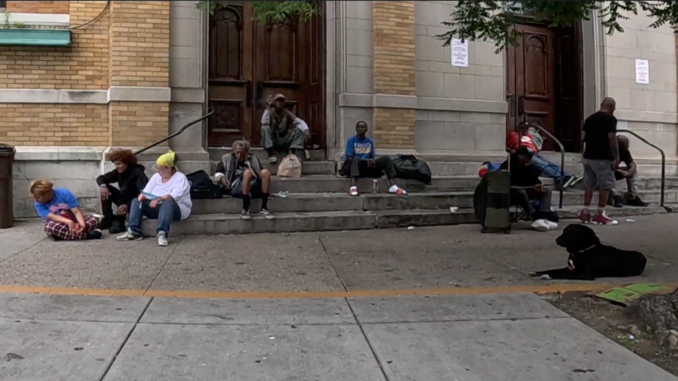
Estimated reading time: 11 minutes
The Cincinnati Police Department announced their plan to barricade the northern portion of the Over-the-Rhine neighborhood near St. Francis Seraph Church at the beginning of May, 2024. Members of the police and various city officials claimed crime was skyrocketing in Over-the-Rhine, and that St. Francis Seraph Church was responsible for attracting crime by giving resources to the homeless.
These plans were implemented on May 13. Water barricades were placed on Republic, between Liberty and Green Streets, for a six month trial period. In addition to this, fencing was built around a recreation center preventing homeless people from finding shade and shelter. All of this with the supposed purpose of stopping an “open-air drug market” and stopping crime.
But who is defining what ‘crime’ is? How is a church providing for the hungry viewed as “attracting” crime? Why is a child going hungry, in itself, not viewed as a crime when it’s perpetuated by our own government? The answer is that spikes in “crime” are nothing more than code for a rise in poverty and state repression. These have been caused by the worsening economic conditions in Cincinnati and the gentrification of the neighborhood of Over-the-Rhine.
The gentrification of Over-the-Rhine has been an ongoing process catalyzed by the murder of an unarmed Black man named Timothy Thomas in 2001. This was coupled with public outrage from the community in response to yet another murder of a Black person by police. The rebellion gained momentum; boycotts and protests put pressure on the city. The Black United Front and the Over-the-Rhine People’s Movement were just a few of the organizations involved in the struggle. To stomp this rebellion and ensure profitable control of the neighborhood, the privatization of the public planning department in the form of a nonprofit development corporation named 3CDC (Cincinnati Center City Development Corporation) was implemented in 2003. This process was dubbed “urban revitalization.”
Dan La Botz summarizes this history as follows in Cincinnati: A Decade Since the Rebellion of 2001 — What Have We Learned, Where Are We Now?:
Cincinnati exploded in protest and rebellion in April and May of 2001 following the April 7 police killing of 19-year old Timothy Thomas, the fifteenth African American man under the age of 50 to be killed by the police between 1995 and 2001. While several of those killed had drawn guns and shot at or shot civilians or police, others did not have firearms or were killed while in police custody. Thomas, who had committed many misdemeanors and had several warrants for his arrest (but who had no record of violence) was nevertheless chased into an alley, shot and killed by a police officer. Thomas’s mother Angela Leisure showed up at City Hall accompanied by 200 other community members, almost all of them Black, to demand that city and police officials explain why her son had been killed, but police and politicians dealt with her contemptuously.… The Cincinnati rebellion of 2001 was the largest disturbance in the city since the ghetto rebellion of 1967 and the largest in the United States since Los Angeles riots of 1992 which began with the police beating of an African American man named Rodney King.
After the riots, a real estate consultant named John Alschuler based in Washington D.C. was brought in to advise the city of Cincinnati on how to best handle the situation: “Over-the-Rhine has to be restored as a mixed-income neighborhood where poor-, moderate-, and upper-income people all have a future… create a private entity with the capacity to deliver change at Fountain Square and Over-the-Rhine, devote capital to it, and hire the foremost talent in the country to staff it.”
In 2003, Mayor Luken appointed P&G CEO A.G. Lafley and Federated Department Stores chairman James Zimmerman to “a new private, nonprofit group charged with sparking downtown’s struggling economic development efforts.” This would come to be the Cincinnati Center City Development Corp, otherwise known as 3CDC — a non-profit development corporation dominating what should be controlled by the people. During this time, the nascent 3CDC started sending out “ambassadors of goodwill.” The clear intention was to send out wholesome and cheerful representatives to the community, but in practice they acted as private security guards, enforcing the interests of the organization and its goals. They leveraged state power to “clean up” downtown. Instead of solving the underlying problems behind poverty and crime, they simply sought to kick it somewhere else.
One of the ambassadors themselves admitted to the reality of their role. “We’re pretty much looked at as security guards who are setting a higher standard,” an ambassador said. They essentially acted as auxiliary police units. Ambassadors would patrol Over-the-Rhine and look in shop windows “for a signal from an employee that everything is fine or something is amiss.” If they spotted an “unruly customer” or potential robbery, they would call the police. Ambassadors dealt with “everything from drug addicts ranting and raving and threatening our customers to a fight breaking out…” said Gary Gabbard, manager of Donato’s on Main St. 10. Small business owners like Gary use what little power they have to be petty tyrants towards the impoverished and call upon auxiliary police units to police communities. Settlers collaborate with the state to act as ambassadors and subjugate marginalized groups.
St. Francis Seraph — the church that has been frequently providing aid services to the community of Over-the-Rhine — had planned on converting a nearby portion of the church into a shelter through the nonprofit Tender Mercies. A member of the local neighborhood watch and various city officials claimed this would lead to increased crime and that the neighborhood was out of control.
“You can’t put investment dollars in a neighborhood that’s out of control,” said Chris Frutkin, owner of City Center Properties. “That behavior would never happen south of Liberty Street.”
The lives of people are easily outweighed by numerical investments to Chris and the class of business owners. They’re more than happy to demonize victims of poverty to protect their own profit, and push narratives of crime being “out-of-control.” America’s economic and social system is maintained in part through stigmatization and individualism. It attempts to place any blame solely upon the individual. Poor people are painted with a general image of immorality; stereotyped as lazy, stupid, bad, or as violent criminals. With this falsehood, a person is able to justify walking past another human begging on the street in 100°F heat without a second thought. With this falsehood, members of a community can be lulled into inaction as repressive powers are built to crack down on them as soon as medical bills get too high or the stock market too low.
“We’re hoping that it could be a form of affordable housing with supportive services to get some of these people off the street into decent housing,” said Father Al Hirt, St. Francis Seraph pastor. “The Franciscans would love to see it used that way, more than some boutique hotel or something.”
Unfortunately, according to WCPO, this was not successful: “The nonprofit Tender Mercies had hoped to buy the St. Francis Seraph friary and applied to the Ohio Housing Finance Agency for low-income historic tax credits for the $21 million project. But the housing finance agency’s board declined to fund the project, according to a May 15 news release.”
Furthermore, the barricade has been a “success” for the settlers:
“So far, so good, let’s wait and see,” said Over-the-Rhine Community Council President Kevin Hassey. “I’m encouraged… there are more police in the area, particularly north of Liberty.”
The notion that crime is on the rise and needs to be rectified in the form of more police ultimately benefits the people in power — the landowners, the police, real estate developers. The police enforce their authority for the state, but that authority is not neutral, as their power is used to protect the interests of businesses to ensure profit and subjugation of colonized peoples. The planned barricade is a fascist attack on people who have been labeled by the state as deserving of extreme poverty and violence. Systematic inequalities perpetually enforced by the state are the root causes of homelessness.
This barricade is a manifestation of the police fulfilling their historic role as slave patrols. Increases in visible poverty and the misery it causes are due to capitalism and settler colonialism functioning to keep working and colonized people exploited — the necessary counterpart to the siphoning of wealth created by workers into the pockets of business owners. Over-the-Rhine isn’t the only target. Several neighborhoods in Cincinnati are also the target. Camp Washington is one example. The Camp Washington Urban Revitalization Corporation even got the neighborhood of Camp Washington selected by the Congress for the New Urbanism for a new renovation project that will displace the renters and houseless people in the area for a walkable neighborhood benefiting wealthier clientele. It’s part of a multi-faceted approach to continue the colonization of land in Cincinnati for increased profits. The iron fist of the state and the invisible hand of the “free market” are limbs of the same body of the illegitimate settler republic of the United States of America.
Police don’t prevent crime and don’t serve the people. They exist to protect the people in power. “Urban revitalization” does not benefit communities, but displaces renters and the houseless by increasing the property values of the neighborhood and drawing in a wealthier clientele. Urban revitalization utilizes the police to displace homeless people and victims of poverty so the land can be remade into luxury condos to make a profit and draw in wealthier white residents. This is exactly what happened with the murder of Timothy Thomas by Cincinnati police and this process is continuing before our eyes. It’s manifesting as a police barricade in the very same neighborhood.
Furthermore, 3CDC is continuing its mission of gentrification, better described as urban settler colonialism: Joe Rudemiller, vice president of marketing and communications for 3CDC said, “We’re going to try to replicate what we’ve done south of Liberty… and hopefully that takes care of some of the issues that we’ve been seeing. We are definitely seeing some challenges with safety up here, and that has been a pervasive problem.” This isn’t some past event to lament. Gentrification is a process that is happening RIGHT NOW and perpetuating white supremacy and impoverishment.
Remember that gentrification is not inevitable — stand up against business interests in your neighborhood! Don’t trust the police and real estate developers who seek to control the neighborhood on behalf of the ruling classes. Protect the homeless people in your neighborhood, and find solidarity against the ruling classes which will crush you both to put a penny in their pocket.

